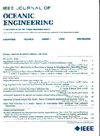仿生水下通信的研究趋势及技术成熟度分析
IF 5.3
2区 工程技术
Q1 ENGINEERING, CIVIL
引用次数: 0
摘要
水下仿生通信(UBC)技术的研究是为了克服人工声通信信号物理隐蔽性的限制。最近的进展表明,数据传输速度为300 b/s,模拟水平难以察觉,通信距离可达60公里。虽然这些结果提高了对实际应用的期望,但该技术的实际性能和成熟度仍不清楚。本文调查和评估现有的仿生通信方法,以阐明UBC技术的当前水平,以规划发展战略。为了分析它们的性能,我们根据哨声和咔哒声等声音类型和调制技术对它们进行了分类。同时,这些方法的技术成熟度也使用技术准备水平框架进行评估。结果表明,仿生通信是一种更有前途的解决军事水下通信隐蔽性要求的方案。最后,我们提出了进一步将该技术发展为完全可操作系统的研究方向。本文章由计算机程序翻译,如有差异,请以英文原文为准。
Analysis of Research Trends and Technological Maturity of Biomimetic Underwater Communication
Underwater biomimetic communication (UBC) technology has been studied to overcome the restricted physical covertness of artificial acoustical communication signals. Recent advancements have demonstrated data transmission at 300 b/s with imperceptible mimicry levels and communication distances of up to 60 km. While these results have raised expectations for practical applications, the actual performance and maturity of this technology have remained unclear. This article investigates and evaluates existing biomimetic communication methods to clarify the current level of UBC technology to plan a development strategy. To analyze their performance, we classified them based on sound types, such as whistles and clicks, and modulation techniques. Simultaneously, the technological maturity of these methods is also assessed using the technical readiness level framework. The results show that biomimetic communication could be a more promising solution for military underwater communication requiring covertness. Finally, we suggest research directions to further develop this technology into a fully operational system.
求助全文
通过发布文献求助,成功后即可免费获取论文全文。
去求助
来源期刊

IEEE Journal of Oceanic Engineering
工程技术-工程:大洋
CiteScore
9.60
自引率
12.20%
发文量
86
审稿时长
12 months
期刊介绍:
The IEEE Journal of Oceanic Engineering (ISSN 0364-9059) is the online-only quarterly publication of the IEEE Oceanic Engineering Society (IEEE OES). The scope of the Journal is the field of interest of the IEEE OES, which encompasses all aspects of science, engineering, and technology that address research, development, and operations pertaining to all bodies of water. This includes the creation of new capabilities and technologies from concept design through prototypes, testing, and operational systems to sense, explore, understand, develop, use, and responsibly manage natural resources.
 求助内容:
求助内容: 应助结果提醒方式:
应助结果提醒方式:


